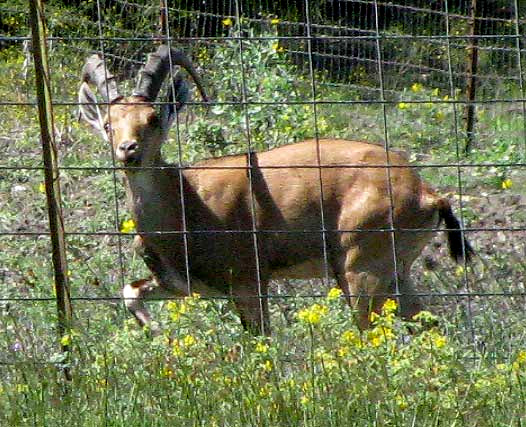Excerpts from Jim Conrad's
Naturalist Newsletter
from the October 7, 2012 Newsletter issued from the valley of the Dry Frio River in northern Uvalde County, southwestern Texas, on the southern border of the Edwards Plateau; elevation ~1750m (~5750 ft); N29.62°, W99.86°; USA
NUBIAN IBEX
One day as I was birding-biking out in the county I passed a ranch with several goats grazing in a pasture. One of the goats was smaller than the others, mostly brown, and bore an impressive set of curved-back horns unlike any I'd ever seen on a goat. That's why I was looking at the goat when it happened.
The goat, apparently made nervous by my stopping to look at him, suddenly shot straight into the air and landed on the other side of the fence he'd been standing beside. No goat I've ever heard of possibly could have cleared that fence!
A few weeks passed until the brown goat appeared again, peacefully grazing in another roadside pasture a few miles away. This time I got the picture you can see below:

Even with the picture on my laptop screen I had no idea what I was seeing -- not with those heavy, curved-back horns with such heavy, widely spaced rings.
Several "hunting ranches" operate in the area catering to hunters wanting to kill exotic animals. Doing an Internet search on "Texas hunting ranches" I found lists of exotic mammals people were invited to come and shoot for hefty sums of money. Axis Deer, Fallow Deer, Blackbuck Antelope, Aoudad Sheep, Russian Boar... all and much more can be hunted right here in Uvalde County, Texas.
So, I'd find the name of an exotic animal these ranches want people to pay to shoot and I'd do an image search on it. I went through about twenty species before I saw our "brown goat." It was a Nubian Ibex, CAPRA NUBIANA, a desert-dwelling goat species found in mountainous areas of Israel, Jordan, Saudi Arabia, Oman, Egypt, Ethiopia, Eritrea, Yemen, and Sudan. A wild population of only about 1200 individuals is known to survive, but they seem to be featured at a good many hunting ranches here. A ranch near here offers the possibility to kill one for "$9,500 - up."
On the IUCN Red List of Threatened Species Nubian Ibexes are listed as endangered species with an EN C2a classification. EN means endangered, and C2a means that the population estimate is less than 2,500 mature individuals, with no subpopulations greater then 250 mature individuals, and an overall declining population trend.
So, somebody's endangered $9,500 has escaped, and now grazes with goats in Uvalde County, Texas.
CBS's "60 Minutes" has looked into the matter of hunting exotic species, reporting that "Exotic wildlife has become a billion dollar industry in Texas supporting more than 14,000 jobs." You can find the interview by searching on the keywords "CBS can hunting endangered animals save the species."